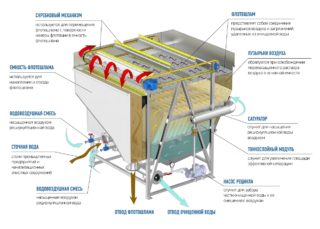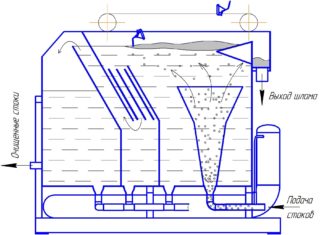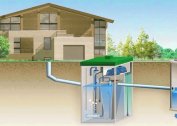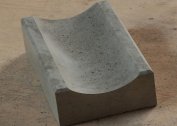Flotation - removal of finely dispersed impurities incapable of wetting from wastewater using specially created gas bubbles. The dirty foam formed in this case is on the surface and is eliminated. For work, various types of devices are used - flotators. Process efficiency is largely determined by their technical characteristics, productivity and automation.
Design and purpose of flotators
Liquid purification is carried out using flotation block plants. The main components of the devices are:
- a container with a pump that mixes oxygen with liquid and reagents;
- flotation tank with valve to eliminate excess air;
- degasser to remove residual oxygen.
Flotation units are not used as independent cleaning tools. They are used in combination at the treatment plants of industrial enterprises and car washes, since they require preparation - mechanical treatment of sewage.
Action chart
The principle of operation of the flotation unit is quite simple:
- The effluents fall into the working tank, where they are enriched with fine air.
- The mixture enters the flotation chamber, where hydrophobic debris interacts with gas bubbles.
- Gradually, a decrease and rupture of the layer separating the hydrophobic particles and air bubbles occurs. This is due to a change in the surface tension of water.
As a result, dirty foam appears on the surface of the liquid. Its removal occurs using special rake devices.
Flotation in devices is a forced process when the density of garbage particles artificially decreases.
Flotation techniques
 Classification of flotators is carried out according to the method of formation of gas bubbles. More commonly used flotation methods:
Classification of flotators is carried out according to the method of formation of gas bubbles. More commonly used flotation methods:
- mechanical;
- pressure head;
- vacuum;
- biological;
- electrochemical.
Pressure flotation is an easy way to treat wastewater when reagents are added to the liquid and oxygen is pumped under high pressure. Bubbles form over the entire volume of sewage. This method is often used to cleanse liquid from activated sludge. Technology involves a saturation chamber.
In electroflotators this node is not. The technique does not require electroflotation and reagents. It involves the removal of suspensions from a liquid using electric current. An electrolysis process is carried out in an electroflotator: hydrogen is released at the cathode, and oxygen is generated at the anode.
The principle of operation of the vacuum device is to lower the pressure below atmospheric in the flotation tank. In this case, air dissolved in water is released.
Biological flotation is the heating of the sediment after primary treatment with steam and settling it for several days. The resulting bacteria emit gas bubbles. Thanks to them, the sediment particles are flotated into the foam layer, where they are densified and dehydrated. Within five days, the moisture index can be reduced to 80 percent, which makes it possible to simplify subsequent processing.
Features of mechanical flotation
There are several flotation methods for mechanical wastewater treatment:
- The fluid is mixed with a special impeller with blades.This purification technique is carried out without pressure and is well suited for removing coarse and fibrous impurities from the water - hair, threads, wools.
- Wastewater is discharged into a centrifuge (impeller). There they mix, acquiring a homogeneous structure. When moving, contaminated water is enriched with oxygen, small bubbles form. They are able to attract even the remnants of petroleum products.
- The drains are enriched with air using special pipes located at the bottom of the receiving chamber. The method is called pneumatic. It is used when it is necessary to purify effluents that are aggressive for processing them in an impeller or pressureless installation.
During pressure treatment, the level of purification depends on the speed of rotation of the impellers - the higher it is, the better. But you need to calculate the exact acceleration. At a certain stage, streaming turbulence grows, debris flakes may collapse, which reduces the efficiency of the process.
Purification of sewage liquids in mechanical-type flotation units is used when light hydrophobic impurities are present in the liquid - fats, oil residues, oils.
If there are impurities in the effluents that require aggregation, a different method is preferred. Due to significant turbulence, the destruction of pollution molecules occurs, and the quality of purification decreases sharply.
A compromise between the mechanical and pressure methods is the saturation of water with oxygen using a porous material. The direction of air flow here occurs through special plates with slots. The thinner the slit holes in the plate, the smaller the air bubbles and the better the cleansing.
Advantages and disadvantages
The use of flotation devices has both advantages and imperfections. The advantages are:
- ease of maintenance of machines;
- budgeting of most methods;
- high quality and speed of wastewater treatment.
Using the technique, you can remove most of the fine impurities, but not all. The disadvantages also include the need for additional use of reagents in order to increase the degree of hydrophobicity of mud particles. In the case of using an electric flotator, it is necessary to fine-tune the device to create bubbles of the required diameter.
Reagents Used
 To increase the cleaning efficiency, chemical collectors are used:
To increase the cleaning efficiency, chemical collectors are used:
- coagulants - reagents that promote the formation of flakes and are salts of iron and aluminum;
- flocculants (polyacrylamide compounds) - substances that create larger and more stable flakes (flocs);
- acid and alkaline reagents that allow you to adjust the pH. They are added to water to ensure normal working conditions of the two previous types of reagents.
To stabilize foaming, pine oil, phenols, cresol are also used. They allow you to protect the air bubbles from destruction, making them resilient. This helps to remove more contaminants from sewage.
The use of chemicals that can improve the process requires accurate dosage selection, which can only be achieved experimentally.
What determines the quality of cleansing
The following factors affect the effectiveness of the technique:
- resistance of air bubbles to destruction;
- uniform foam formation;
- the degree of hydrophobicity of particles - the larger this indicator, the more actively they interact with air bubbles.
The size of the bubbles is also important. Large ones quickly emerge, and do not have time to capture impurity molecules, while small ones are less durable.
The use of flotation techniques is indispensable for the purification of wastewater from fats, fibrous inclusions, oil products, and other contaminants that are not susceptible to sedimentation. This method is used to clean the sewer and in the enrichment of minerals.




